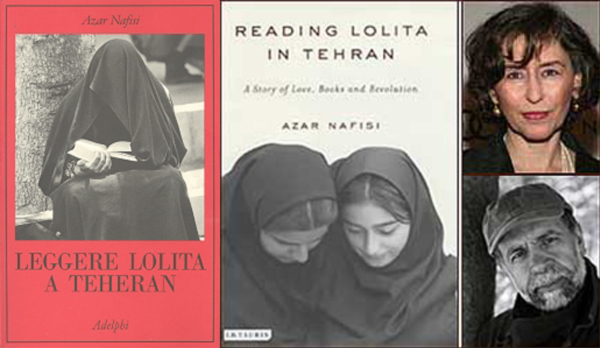
Negar Mottahedeh: Fruits of Total War

I wonder too about the question Radhika raises on constructing a response that expresses outrage. A response that does not at the same time parttake of zones of fear and terror, but also of zones of visual pleasure and fetishism I would add. How do we in the heart of the empire construct a response at all? I wonder at this as my US colleagues who work on Iranian Cultural and Literary Studies attempt to respond to the bravado surrounding Azar Nafisi's fictional memoir READING LOLITA IN TEHRAN -- a gesture that engrains the story of Iranian women in the call for total war.
In READING LOLITA IN TEHRAN the author of the fictional memoir, Azar Nafisi, reflects on her return to Iran after years of studying abroad. Her story is set during the course of the revolution and the first years of the Islamic Republic. Here Nafisi reflects on her work as a University professor in English literature in Tehran and on the ways in which the female body plays a pivotal and assertive role in the formation of the new Republic. Describing a city battered by war, she writes about the students who attended her classes during the 1980s and early 1990s to read "the great books" of the Western canon, including novels by Jane Austen, Henry James, F. Scott Fitzgerald and Vladimir Nabokov. Her goal of describing how her female students, sitting in the private study circle that she founded in 1995, identify their own plight with the plights of Lolita and Elizabeth Bennet is enough to capture one's interest. The writing, too, is gripping. Each of Nafisi's characters "glows on the page," one reviewer writes, "illuminated by Nafisi's affection." Most reviews of the book in the US press are comparably fervent and enthusiastic. "Reading Lolita in Tehran had a most unusual effect on me," writes another reviewer. "I didn't want to be interrupted, so I canceled a dental appointment and a business lunch and missed a deadline. I read and read and ignored the world. This is what brilliant books will do; they seize you until the story is over."
Thomas Hibbs writes of the book in the National Review: "A brilliant and dramatically moving exposition of the power of literature to transform souls and create spaces for the retention of community and identity in the midst of totalitarian oppression." "[T]he book also makes a persuasive case for the way literary masterpieces can aid the ordinary individual in carving out spaces marginally free from the omnipresent totalitarian regime and can provide the basis for alternative forms of community."
And yet, he continues with an air of surprise "Nafisi’s crisply written book has come under fire as an alleged instrument of neoconservative imperialism." Hobbs refers here to Hamid Dabashi's critique of the uses of Nafisi's book for "cultivating US public opinion... against Iran having already done a great deal by being a key propaganda tool at the disposal of the Bush administration during its prolonged wars in such Muslim countries as Afghanistan (since 2001) and Iraq (since 2003)." In his article on READING LOLITA IN TEHRAN, Dabashi writes, "With one strike Azar Nafisi has achieved three simultaneous objectives: (1) systematically and unfailingly denigrating an entire culture of revolutionary resistance to a history of savage colonialism; (2) doing so by blatantly advancing the presumed cultural foregrounding of a predatory empire; and (3) while at the very same time catering to the most retrograde and reactionary forces within the United States, waging an all out war against a pride of place by various immigrant communities and racialised minorities seeking curricular recognition on university campuses and in the American society at large. So far as its unfailing hatred of everything Iranian--from its literary masterpieces to its ordinary people--is concerned, not since Betty Mahmoody's notorious book Not Without My Daughter (1984) has a text exuded so systematic a visceral hatred of everything Iranian. "
It seems undeniable that READING LOLITA IN TEHRAN and its author have been promoted, at least in part, to fulfill the ends of total war. Although human rights violations are ongoing, the urgent concern for the restoration of such rights is not the driving force of the total war in which Nafisi's book has been embedded.
Former Marine Adam Mersereau explains the concept of total war in the National Review. It is a war "that not only destroys the enemy's military forces, but also brings the enemy society to an extremely personal point of decision, so that they are willing to accept a reversal of the cultural trends that spawned the war in the first place." While a total war strategy does not have to "include the intentional targeting of civilians," sparing them "cannot be its first priority. The purpose of total war is to permanently force your will onto another people." The purpose of the total war that is the US-led "war on terror" is to force American values onto a culture that is, at its best and at its worst, ambivalent to it.
For some time before and after the publication of her runaway bestseller, Nafisi was being promoted alongside proponents of total war by Benador Associates, which arranges their TV appearances and speaking engagements and helps to place their articles in the top newspapers. Such neo-conservative luminaries as Richard Perle and James Woolsey, who notoriously referred to the war on terror as "World War IV," are still clients of the agency. In September 2004 when READING LOLITA was topping the bestseller list, Benador Associates agent Eleana Benador traced the cognitive links the neo-conservatives draw between the war and Middle Eastern women in a posting "From Eleana's Desk" on the agency's website: "One of the most memorable experiences [of the 2004 Athens Olympics] was to watch the Afghan woman participating in one of the races, as well as an Iraqi woman. They didn't go far, they were among the last ones. But, watching them, I couldn't avoid thinking: 'We are winning!' Yes, we are winning over extremism, whether religious or secular. More accurately, we are starting to win. The road ahead is still a long one, but the beginning is already giving results. We have rescued from the hands of those extremists these women who have regained their status as human beings, and who are learning now what it is to be treated with respect and dignity."
I urge you to study Hamid Dabashi's analysis of the cover image to the English version of READING LOLITA which shows two teenagers with obligatory veils (thus presumed to be in Tehran) reading with glee (a book presumed to be LOLITA). The titillating connotations of the cover are enough to suggest the book's circulation within an Orientalist phantasmagoric economy.
But the Italian cover to the same book, entitled in Italian LEGGERE LOLITA, suggests more forcefully, the complicity of our own visuality in a system that prescribes the saving of veiled Iranian women in an act of total war. For aren't precisely the contrasting images of unveiled women in hair salons, images of unveiled women enjoying a cut or a blowout, images that suggest US victory to us today? Aren't these precisely the images that are repeatedly drawn upon to connote the fall of the Taliban and parade the fruits of another US-led war?
Negar Mottahedeh
REFERENCES:
Thomas Hibbs National Review Article "What's the Matter with Reading Lolita in Tehran"
"Hamid Dabahsi Al Ahram "Native informers and the making of the American empire"

